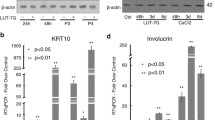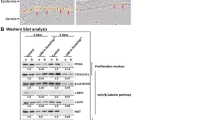Summary
Amiprilose hydrochloride, a 3-substituted glucose derivative, was found to inhibit the proliferation of human fibroblasts and keratinocytes originating from psoriatic lesions. Fibroblasts and keratinocytes were obtained from skin biopsies of normal donors, and from the biopsies of active/involved and uninvolved sites of psoriatic donors. The cells were cultured as monolayers or as components of tissue equivalent models. Keratinocytes and fibroblasts originating from biopsies of psoriatically involved areas were shown to proliferate at a significantly higher rate than those derived from uninvolved areas. The antiproliferative effect of amiprilose hydrochloride was not observed with normal keratinocytes or fibroblasts from the skin of healthy donors or from uninvolved areas of psoriatic donors. Amiprilose hydrochloride was not cytotoxic to any of these cells at levels below 0.1%. The combination of the low cytotoxicity and the selective antiproliferative effect indicates that this compound may be a useful antipsoriatic agent. The use of monolayer cultures and tissue equivalent models in this study illustrates the utility of such a progressive strategy in the evaluation of potential topical pharmaceuticals.
Similar content being viewed by others
References
Baker, W. H.; Wilkinson, D. S. Psoriasis. In: Rook, A.; Wilkinson, E. S.; Ebling, F. J. G., eds. Textbook of dermatology. London: Blackwell Scientific Publications; 1972:1192–2000.
Bauer, F. W.; Crombag, N. H. C.; Boezeman, J. M. B., et al. Flow cytometry as a tool for the study of cell kinetics in skin. II. Cell kinetic data in psoriasis. Br. J Dermatol. 104:271–276; 1981.
Bell, E.; Sher, S.; Hull, B., et al. The reconstitution of living skin. J. Invest. Dermatol. 81: (suppl)2–10s; 1983.
Brinckerhoff, C. E. Decreased cell proliferation and PGE2 production by fibroblasts treated with a modified hexose sugar, Amiprilose Hydrochloride (Therafectin). Agents Actions 30:322–328; 1990.
Chedid, L.; Audibert, F. Recent advances in the use of the synthetic immunoadjuvants muramyl dipeptide and analogues. In: Schlessinger, D., ed. Microbiology. Washington DC: American Society of Microbiology; 1977:388–394.
Fry, L. Psoriasis. Br. J. Dermatol. 119:445–461; 1988.
Garrett, E. R.; Van Peer, A.; Mahrous, H., et al. Properties stability, assay, and preliminary pharmacokinetics of the immunomodulatory 1,2-O-isopropylidine-3-O-[3′,N,N′-dimethylamino-n-propyl]-α-d-glucofuranose hydrochloride. J. Rheumatol. 71:387–395; 1982.
Goldberg, M. The glucose effect; carbohydrate repression of enzyme induction, RNA synthesis and glucocorticoid activity—a role for cyclic AMP and cyclic GMP. Life Sci. 17:1747–1754; 1975.
Gordon, P. Anti-inflammatory actions of an immunomodulator: therafectin [1,2-O-isopropylidine-3-O-(3′-N,N′-dimethylamino-n-propyl)-ga-d-glucofuranose HCl]. In: Willoughby, D. A.; Giraud, J. P., eds. Inflammation: mechanism and treatment. Baltimore, University Park Press; 1980:169–180.
Gordon, P.; Ronsen, B.; Kulkarni, S. V. Antiviral effect of 1,2-O-isopropylidine-3-O-(3′-N,N′-dimethylamino-n-propyl)-α-d-glucofuranose. (SM-1213). Abst. Ann. Meeting. Am. Soc. Microbiol. 74:265; 1974.
Gordon, P.; Ronsen, B.; Mucha, D. P. Rhinovirus: Inhibition of virus multiplication by 1,2-O-isopropylidine-3-O-(3′-N,N′-dimethylamino-n-propyl)-α-d-glucofuranose. Fed. Proc. 32:807; 1975.
Gordon, P.; Shinkai, H.In vivo enhancement of neutrophil turnover by 1,2-O-isopropylidine-3-O-(3′-N,N′-dimethylamino-n-propyl)-α-d-glucofuranose (SM-1213). Abst. Ann. Meetings Am. Soc. Microbiol. 79:14; 1979.
Hadden, J. W. Effect of isoprinosine levamisole, muramyl dipeptide, and SM1213 on lymphocyte and macrophage functionin vitro. Cancer Treat. Rep. 62:1981–1985; 1978.
Hadden, J. N.; Englard, A.; Sadlik, J. R., et al. The comparative effects of isoprinosine, levamisole, muramyl dipeptide, and SM 1213 on lymphocyte and macrophage proliferation and activationin vitro. Int. J. Immunopharmacol. 1:17–27; 1979.
Holtzmann, A.; Bernd, A.; Hohlmaier, K. Proliferation of nonpsoriatic human fibroblastsin vitro by serum from patients with psoriasis. Lancet Vol. II (8618):1031; 1988.
Hood, A. F.; Kwan, T. H.; Burnes, D. C., et al. Primer of dermatopathology. Boston/Toronto: Little, Brown and Company; 1984:43–45.
Iizuka, H.; Matsuo, S.; Tamura, T., et al. Increased cholera toxin- and forskolin-induced cyclic AMP accumulations in psoriatic involved versus uninvolved or normal human epidermis. J. Invest. Dermatol. 91 (2):154–157; 1988.
Kieval, R. I.; Young, C. T.; Prohazka, D., et al. Evaluation of a modified hexose sugar, Amiprilose Hydrochloride, in experimental models of synovitis. J. Rheumatol. 16:67–74; 1989.
Lefrancier, P.; Choay, J.; Derrien, M., et al. Synthesis ofN-acetyl-muramyl-3-O-l-alanyl-d-isoglutamine, an adjuvant of the immune response, and someN-acetyl-muramyl-peptide analogues. Int. J. Pept. Protein Res. 9:249–257; 1977.
Leigh, I. M.; Pulford, K. A.; Ramaekers, F. C. S., et al. Psoriasis: maintenance of an intact monolayer basal cell differentiation compartment in spite of hyperproliferation. Br. J. Dermatol. 113:53–64; 1985.
MacLaughlin, J. A.; Gange, W.; Taylor, D., et al. Cultured psoriatic fibroblasts form involved and uninvolved sites have a partial but not absolute resistance to the proliferation-inhibition activity of 1,25-dihydroxyvitamin D3. Proc. Natl. Acad. Sci. USA 82:5409–5412; 1985.
Morrison, C. J.; Gordon, P.; Hashimoto, T. Enhanced killing ofCandida albicans by cultured peritoneal exhudate cells treated with S.M. 1213. a synthetic immunomodulator. Antimicrobial Agents Chemother 26:74–77; 1984.
Parish, J. A.; Fitzpatrik, T. B.; Tannenbaum, L., et al. Photochemotherapy of psoriasis with oral methoxsalen and long wave ultraviolet light. N. Engl. J. Med. 291:1207–1211; 1974.
Placek, W.; Haftek, M.; Thivolet, J. Acta Dermatol. Venereol. Suppl. 68:369–377; 1988.
Priestley, G. C.; Adams, L. W. Hyperactivity of fibroblasts cultured from psoriatic skin. I. Faster proliferation and effect of serum withdrawal. Br. J. Dermatol. 109:149; 1983.
Priestley, G. C. Hyperactivity of fibroblasts cultured from psoriatic skin. Synthesis of macromolecules. Br. J. Dermatol. 109:157; 1983.
Priestley, G. C.; Adams, L. W.; Oakley, C. A., et al. Proliferative responses of fibroblasts from psoriatic and normal skin to clobetasol propionate. Acta. Dermatol-Venereol. Suppl. 63:393–396; 1983.
Rheinwald, J. G.; Green, H. Serial cultivation of strains of human dermal keratinocytes: the formation of keratinizing colonies of single cells. Cell 6:331–344; 1975.
Saiag, P.; Couloumb, B.; Lebreton, O., et al. Psoriatic fibroblasts induce hyperproliferation of normal keratinocytes in a skin equivalent modelin vitro. Science 230:669–672; 1985.
Smith, E. L.; Pincus, S. H.; Donovan, L., et al. A novel approach for the evaluation and treatment of psoriasis. J. Am. Acad. Dermatol. 19:516–528; 1988.
Valdimarsson, H.; Baker, B. S.; Jonsdittir, I., et al. Psoriasis: a disease of abnormal keratinocytes induced by T lymphocytes. Immunol. Today 7:256–259; 1986.
Van Scott, E. J.; Ekel, T. M. Kinetics of hyperplasia in psoriasis. Arch. Dermatol. 88:373–381; 1963.
Author information
Authors and Affiliations
Additional information
Supported in part by research grants from the National Institutes of Health (AG01274), The R.A. Welch Foundation (B-0502), The Texas, Advanced Technology and Research Program (Wound Healing and Aging #2147), and Greenwich Pharmaceuticals Inc. R. W. G. is the recipient of a MERIT Award from the National Institute on Aging.
Rights and permissions
About this article
Cite this article
Chapman, M.L., Dimitrijevich, S.D., Hevelone, J.C. et al. Inhibition of psoriatic cell proliferation in in vitro skin models by amiprilose hydrochloride. In Vitro Cell Dev Biol 26, 991–996 (1990). https://doi.org/10.1007/BF02624474
Received:
Accepted:
Issue Date:
DOI: https://doi.org/10.1007/BF02624474




